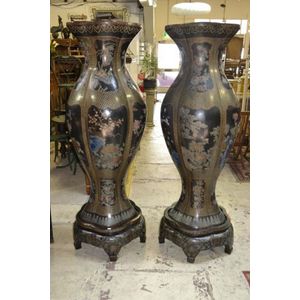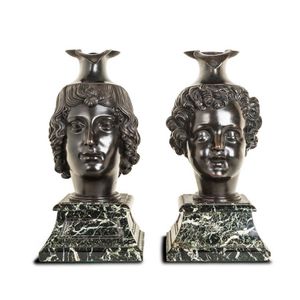Italian Bronze Head Oenochoe on Verde Marble Plinths
A pair of North Italian bronze head oenochoe on verde marble plinths, after the Antique in the etruscan style, 48 cm high
You must be a subscriber, and be logged in to view price and dealer details.
Subscribe Now to view actual auction price for this item
When you subscribe, you have the option of setting the currency in which to display prices to $Au, $US, $NZ or Stg.
This item has been sold, and the description, image and price are for reference purposes only.
- Etruscan Revival Style - The Etruscan revival style is based on the ancient art and architecture developed by the Etruscan civilization that lived in central Italy between the 8th and 3rd centuries BCE. In ceramics and decorative arts the Etruscan style is characterised by its ornate and intricate designs, as well as its use of vibrant colours. Etruscan pottery was often decorated with scenes from daily life, myths and legends, and animal and floral motifs, rendered in relief or painted. Etruscan metalwork, such as jewellery and vessels, also displayed a high degree of skill and sophistication, with intricate designs featuring mythical creatures and animals. Additionally, the Etruscan style is known for its use of the bucchero technique, which involved creating a black, matte surface on pottery by reducing the oxygen in the firing process. This style of decoration was widely adopted by other cultures in the ancient Mediterranean world.
- Bronze - An alloy of copper and tin, traditionally in the proportions of about 9 parts of copper to 1 part of tin.
The discovery of bronze in Western Asia in the 4th century enabled people to create metal objects which were superior to those previoulsy possible because of its strength and hardness, and it has been used throughout the world for weapons, coins, tools, statuary and other decorative items.
It is very fluid in a molten state, and its hardness, strength when set, and non-corrosive properties makes it most suitable for casting sculpture. - Etruscan - The Etruscans were pre-Roman people who mainly inhabited central and part of north Italy, in the area corresponding to Tuscany. The civilisation was active from around 700BC until their assimilation into the Roman Empire in around the 4th century BC.
With the increasing importance of Rome they were virtually wiped out, for Rome would not tolerate a competitive civilization. Many Etruscan rituals and aspects of their culture were taken over by Rome: Etruscan funeral games became the Roman gladiatorial combats and the science of divination came from the Etruscans.
They were also incredible craftsmen in precious metals. It was said that the famous Etruscan Sibylline books of received wisdom were burnt by Rome and that the emperor Claudius was the last person who could read Etruscan, a language that is still largely undeciphered.
Black and red figure vases attributed to the Etruscans provided the basis for the Etruscan style of furniture, decorative arts and decoration first seen in Louis XVI furniture in the 1760s, and then adapted by Robert Adam in England.
The style was characterised by the use of the red and black colourways of the vases, together with motifs such as lions, birds, sphinxes and griffins.
Josiah Wedgwood was inspired by the civilisation, and in 1769 he opened his new ceramic factory at Stoke-on-Trent, naming it "Etruria Works". Using the modeller John Flaxman, he produced wares based on what was thought at the time, to be Etruscan themes.
At the end of the 18th and in the early 19th century, Etruscan themes were seen in glass, jewellery and furniture, and in the 1820s Coalport China produced a range of wares based on the Etruscan themes.
Around that time it was discovered that the archaeological treasures attributed to the Etruscans were of Greek origin, but the description of them as "Etruscan" continued. - Oenochoe / Oinochoe - An oenochoe, also spelt oinochoe is an Ancient Greek wine jug or a modern jug usually silver, made in the same form, with a single curved handle and is usually taller than it is wide.
This item has been included into following indexes:
Visually similar items

Japanese bronze pair of vases with two handles & floral design. Height 20.5 cm
Sold by
in
for
You can display prices in $Au, $US, $NZ or Stg.

A pair of massive Oriental palacial Laquered papier mache vases on matching stands, decorated with cartache of lotus and peonies etc
Sold by
in
for
You can display prices in $Au, $US, $NZ or Stg.

A pair of Oriental bronze vases, signed, 19th century. Adorned with birds, 47 cm high
Sold by
in
for
You can display prices in $Au, $US, $NZ or Stg.

A Japanese bronze two handled vase, ovoid shape raised on a petal skirted three legged base. Height 18 cm.
Sold by
in
for
You can display prices in $Au, $US, $NZ or Stg.
